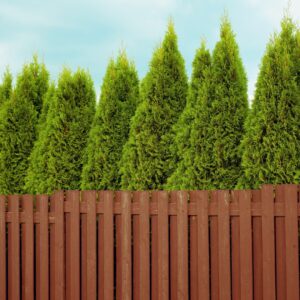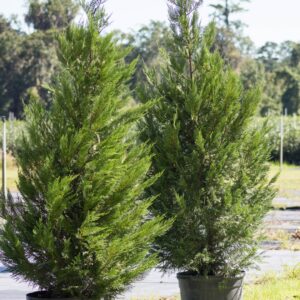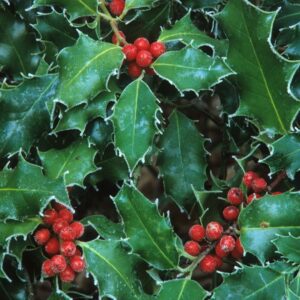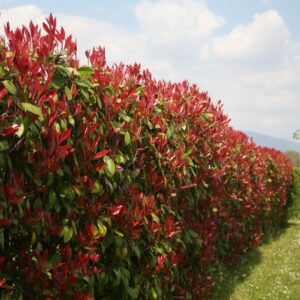
Classic Trees and Shrubs for Living Privacy Walls
Why Plant A Living Privacy Fence?
No one wants to feel on display in the comfort of their own home. This is just as true in our yards as it is in our living rooms. While traditional fences can help create some privacy, they rarely do it as well as trees and shrubs can.
- Trees and shrubs can grow significantly taller
- They cost a lot less than building a tall fence
- Fences break down over time and need constant maintenance. Privacy trees and shrubs simply need some time to get established. Once they are grown, living privacy walls rarely need fertilizer and their water and pruning needs can be as minimal as you want them to be.
- Many trees and shrubs are better suited for blocking noise and wind than man-made fences, especially if you choose plants with dense foliage.

What Should You Look For in Trees and Shrubs for Privacy?
There are tons of trees and shrubs that look great and grow tall, but not all of them make the cut as a great choice for privacy. When considering what to plant, there are a few key factors you need to think about first.
Environmental Factors
Environmental factors are key in deciding what kinds of trees or shrubs to plant.
- Will they grow in your hardiness zone? (All of the plants listed below will thrive in our growing zone 7!)
- What is the sun exposure in the area where you need privacy?
- Is there any pavement nearby that can be disrupted by shallow roots?
- How is the water drainage in the area, or the soil quality?
- Are there any telephone wires that will need to be pruned around if your tree grows too tall? (This one is important: there is nothing weirder than a tree with a great big circle pruned out of it to make way for telephone wires.)
- Are you trying to block the noise of a nearby highway or simply creating a little shield between you and your next door neighbor?
- How close is your neighbors’ yard, and is there a chance your plants could spill over onto their property?
Aesthetics
Then, consider how you want your privacy wall to look.
- Do you want a clean wall in a straight line?
- Do you want pops of color throughout the year?
- Do you want your privacy wall to look consistent all year? (If yes we recommend evergreen trees.)
- Do you want to mix different kinds of trees and shrubs to create texture?
- Do you want to plant an extra thick wall to block strong gusts of wind?
- How tall do you want your wall to be?
Budget
Lastly, consider your budget.
If you are in a position to plant great big fully-grown trees, you won’t need to think about how fast a tree or shrub grows.
If you want to start with young, more affordable plants, then you’ll need to think about how long you want to wait until the living privacy wall is actually providing any privacy – the faster the plant grows the faster you can feel comfortable and secure within your living walls.

What Are The Classic Choices For Living Privacy Walls?
While we could list dozens of types of plants that will create attractive privacy, we want to keep things simple. Here are our top 7 classic tree & shrub choices to create privacy around your home.
Thuja Green Giant
This hybrid arborvitae grows incredibly fast and packs a punch in a very tall package. Be prepared to allow up to 60 feet of clearance for these tall trees. They really only need full to partial sun, water once a week until established and then two to three times a month after that, and a balanced fertilizer in the spring to encourage nice thick foliage. The naturally tall, conical shape means they don’t need pruning, which is good since pruning a tree 50 feet in the air would be hazardous. We love these for single-row fences or staggered plantings in order to create a wind and noise barrier from highways.


Emerald Green Arborvitae and/or American Pillar Arborvitae
These are also hybrid arborvitae, but they only grow to be about 15 feet tall to 25 feet tall at the most. If you like the thick columnar look of arborvitae but you don’t have the space for the bigger varieties, these are the trees for you. Again, they prefer full sun but can tolerate partial sun, water once a week until established then only twice a month as needed, and light balanced fertilizer or compost in the spring. The bright green foliage on the Emerald Green Arborvitae is an added bonus since it has a lighter, brighter color & thicker foliage than its faster-growing and narrower counterpart, the American Pillar Arborvitae.
Leyland Cypress
The Leyland Cypress is another perfect choice if you need your privacy wall to grow very quickly. These trees need less water than arborvitae (and more soil drainage), so once they are established they will need less upkeep overall. While they stay relatively narrow, Leyland Cypress trees can reach up to 60 feet tall once fully grown.


Eastern Red Cedar
The native choice for privacy, Eastern Red Cedars are actually native juniper trees (Juniperus virginiana), and they are great for privacy, creating food, and shelter for local birds. These trees are wider than some other choices so they need to be spaced out more, and they have a more moderate growth rate than fast-growing hybrids. Make sure to allow up to 50 feet of clearance overhead, since they do grow nice and tall. Once established they will need very little upkeep.
Nellie Stevens Holly Trees
Large, classic holly trees bring delightful winter interest along with their ability to create a barrier between the world and your own personal winter wonderland. The red berries are loved by birds when food is scarce, and the sharp green foliage lasts all year long. These holly trees grow up to 25 feet high, and you can space them out to enjoy their conical growth habit or bring them closer together for a continuous living wall. Either way, these are a great way to create both privacy and some shade – decorate your Nellie Stevens Holly privacy wall with flowering shrubs that appreciate some afternoon shade such as hydrangeas. The deep green will help make the flowers really pop!


Photinia
Photinia is a popular fast-growing evergreen shrub that is often used as a fence row or hedge. The oval leaves of red-Tipped photinia plants start out red but turn into dark evergreen after a couple of weeks. During the spring, photinia also has small white flowers that produce red fruits, which often last into the winter. To avoid photinia disease be sure to provide well-drained soil so that it isn’t too wet. Photinia plants also prefer full sun, but they can tolerate partial shade.
Skip Jack Cherry Laurel
Another fast-growing plant, a Skip Cherry Laurel can reach up to 12 – 18 feet high and they’ll get there quickly, growing up to 2 feet per year. These evergreen shrubs also grow into a beautiful continuous hedge if you place them close enough together, with their green leaves flowing together all year long. Skips don’t need much pruning, but a quick prune early in the season will help give them a crisp, classic look to your wall of privacy shrubs.

Not sure which privacy tree is right for you? Come visit our garden center in Bowie, MD – our trees and shrubs team can help make recommendations specific to your needs. We can even show you around our trees and shrubs and help you pick out the ones you want to have delivered! We look forward to you visiting our garden center and helping you make the perfect amount of privacy for your home.



